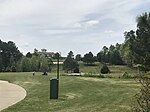Yates Mill
Buildings and structures in Raleigh, North CarolinaGeography of Raleigh, North CarolinaGrinding mills in North CarolinaGrinding mills on the National Register of Historic Places in North CarolinaIndustrial buildings completed in 1756 ... and 8 more
Industry museums in North CarolinaMill museums in North CarolinaMuseums in Raleigh, North CarolinaNational Register of Historic Places in Raleigh, North CarolinaNorth Carolina State UniversityParks in North CarolinaPre-statehood history of North CarolinaProtected areas of Wake County, North Carolina

Yates Mill is a fully restored, circa 1756 gristmill located five miles (8 km) south of downtown Raleigh, North Carolina, United States. It is the centerpiece of Historic Yates Mill County Park, in central Wake County. The park features the restored mill; a visitor center with a museum focused on milling and on the natural history of the area, classrooms, an auditorium and space for research conducted by North Carolina State University faculty and students; a 20-acre (81,000 m2) lake; and extensive hiking trails. The park is managed as a native wildlife refuge with a mission to study and interpret the park's cultural, natural and agricultural heritage.
Excerpt from the Wikipedia article Yates Mill (License: CC BY-SA 3.0, Authors, Images).Yates Mill
Millpond Trail,
Geographical coordinates (GPS) Address Nearby Places Show on map
Geographical coordinates (GPS)
| Latitude | Longitude |
|---|---|
| N 35.718577777778 ° | E -78.688341666667 ° |
Address
Millpond Trail
27693
North Carolina, United States
Open on Google Maps







